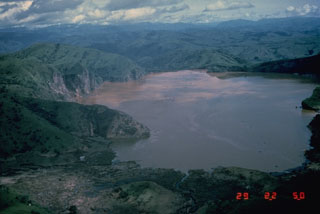Report on Oku Volcanic Field (Cameroon) — December 1986
Scientific Event Alert Network Bulletin, vol. 11, no. 12 (December 1986)
Managing Editor: Lindsay McClelland.
Oku Volcanic Field (Cameroon) Three explosions in 5 minutes; red stain in lake center the next morning
Please cite this report as:
Global Volcanism Program, 1986. Report on Oku Volcanic Field (Cameroon) (McClelland, L., ed.). Scientific Event Alert Network Bulletin, 11:12. Smithsonian Institution. https://doi.org/10.5479/si.GVP.SEAN198612-224030
Oku Volcanic Field
Cameroon
6.25°N, 10.5°E; summit elev. 3011 m
All times are local (unless otherwise noted)
The following is from Haroun Tazieff.
"Rose-Marie Chevrier spent 4 days at Lake Nyos, 30 December-2 January. During this period, she carried out a series of measurements of the CO2 content, pH, and electrical conductivity of the air, lake water, and soil. She collected a series of gas, water, soil, and rock samples that will be analyzed in the laboratory.
"On 30 December at 1955, she felt slightly unwell as she measured the CO2 content of the air, discovering that it was ~4x the normal value that she had previously measured. The night was moonless and the weather foggy. At 1959, an explosion occurred in the lake, followed within 3 minutes by two stronger ones. The last one was accompanied by one flare of white light. The next morning, a red stain, 200 m across, was observed in the central part of the lake, which is ~800 m wide [see also 12:1]. Such a stain had been observed during the week that followed the catastrophic event of 21 August (see report by Tazieff, LeGuern, and Faivre-Pierret). On 31 December, Chevrier received evidence from several witnesses that similar stains had also been observed one week before. These red stains are most probably due to the colloidal oxidized iron on the silt accumulated on the lake bottom, 220 m below the surface.
"These facts tend to corroborate the phreatic eruption hypothesis to account for the 21 August disaster. They also show that the phreatic crisis is not yet over and that the phreatic eruption that occurred in December and probably those that could still occur will be far less violent than the 21 August event. To the contrary, the latter ones are not accompanied by a huge amount of practically pure CO2. The fact that a few minutes before the first 30 December eruption the CO2 content in the air had almost certainly been quadrupled is most likely due to the initial phase of the phreatic eruption. Experience previously acquired by the team Tazieff, LeGuern, Chevrier, and Faivre-Pierret induced us to ascribe this content increase to the sudden release of the trapped gas from its deep-seated reservoir. Such a release begins with the opening of narrow fissures in the rock reservoir cap. The affected section of these fissures allows a small amount of accumulated gas phase to escape. It escapes, because of its own pressure and the thinness of the fissure section, at very high, even supersonic, speed. The total amount of gas released during this initial phase is comparatively small but large enough to pollute the atmosphere. This initial phase ends when the total effective section of the fissure has been enlarged by mechanical abrasion of the violent gas stream over a certain threshold, above which huge amounts of gas phase may be rapidly liberated, so starting the second or main phase of the phreatic eruption. The first phase according to our own experience lasts some tens to a few hundreds of seconds. The main phase lasts until the gas pressure in the reservoir is high enough to provide the violent emission, characterizing this type of event, ending abruptly because the water acts as a stopper. Subaerial eruptions finish more progressively as at Soufrière or Dieng, or even last for a few months."
Geological Summary. Numerous maars and basaltic cinder cones lie on or near the deeply dissected rhyolitic and trachytic Mount Oku massif along the Cameroon volcanic line. The Mount Oku stratovolcano is cut by a large caldera. The Oku volcanic field is noted for two crater lakes, Lake Nyos to the N and Lake Monoun to the S, that have produced catastrophic carbon-dioxide gas release events. The 15 August 1984 gas release at Lake Monoun was attributed to overturn of stratified lake water, triggered by an earthquake and landslide. The Lake Nyos event on 21 August 1986 caused at least 1,700 fatalities. The emission of ~1 km3 of magmatic carbon dioxide has been attributed either to overturn of stratified lake waters as a result of a non-volcanic process, or to phreatic explosions or injection of hot gas into the lake.
Information Contacts: F. LeGuern, CNRS, France.

